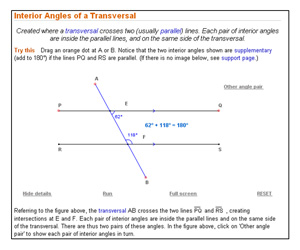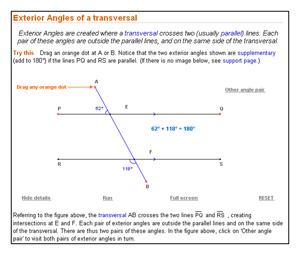
In this activity, you will use an interactive dynamic geometry sketch to investigate the relationships between the measures of corresponding angles, alternate interior angles, and alternate exterior angles. Click on this link to open the following exercise and follow the instructions below:

![]() Interactive Transversal Angles
Interactive Transversal Angles
Before starting click on Unlock lines and Toggle Grid.
Respond to the questions below in your notes.
Interactive popup. Assistance may be required.
They are congruent.

Interactive popup. Assistance may be required.
They are congruent.

Interactive popup. Assistance may be required.
They are congruent.

Interactive popup. Assistance may be required.
Notice that the congruent relationships are not true when the lines are not parallel.

Now, let's investigate two more angle relationships in parallel lines. Open the following exercise and follow the instructions below:

![]() Interior Angles of a Transversal
Interior Angles of a Transversal

Source: Math Open Reference – Interior Angles of a Transversal
Two angles that are in the interior region between two parallel lines and on the same side of the transversal are called... Interactive popup. Assistance may be required.
same-side interior angles or consecutive interior angles

Respond to the questions below. Click the links below to check your answers.
Interactive popup. Assistance may be required.
Observe that the consecutive interior angles are supplementary; that is, the sum of their measures always equals 180°.

Interactive popup. Assistance may be required.
Observe that the relationship does not hold true when the lines are not parallel.

To investigate the last pair of special angles, open the following exercise and follow the instructions below:

![]() Exterior Angles of a Transversal
Exterior Angles of a Transversal

Source: Math Open Reference - Exterior Angles of a Transversal
Two angles that are in the exterior region outside of two parallel lines and on the same side of the transversal are called... Interactive popup. Assistance may be required.
same-side exterior angles or consecutive exterior angles

Respond to the questions below. Click the links below to check your answers.
Interactive popup. Assistance may be required.
Observe that the consecutive exterior angles are supplementary; that is, the sum of their measures always equals 180°.

Interactive popup. Assistance may be required.
Observe that the relationship does not hold true when the lines are not parallel.
